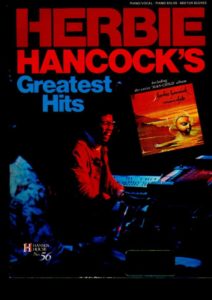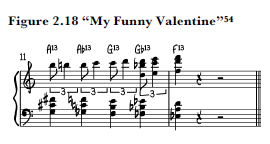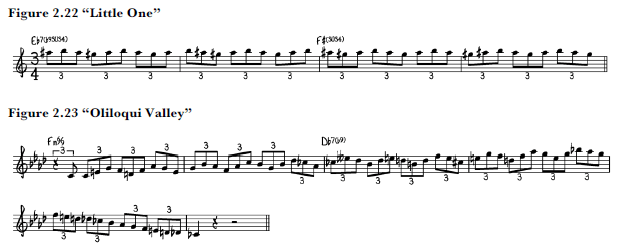Analysis Hancock’s Melodic Line
Browse in the Library:
Or browse in the categories menus & download the Library Catalog PDF:
Herbie has a great linear harmonic sense, in that his phrases are elongated in a very beautiful way – they not only come out of something, they automatically lead back into something else.
Oscar Peterson
Following on from the material discussed in the previous chapter (1/3), this part examines the other side of Herbie Hancock’s musical coin – it focuses on the characteristics unique to Hancock’s style.
One of the most notable ways Hancock achieves the manner of phrase described by Oscar Peterson above is through his use of musical sequence, and as such a large proportion of this chapter is dedicated to examining the variety of methods in which Hancock employs this device.
While the previous chapter discussed the fundamental technical elements of the jazz language, the following analysis does not delve into the core melodic or harmonic construction of each sequence; it instead provides a contextual overview of the device. To continue the jazz language metaphor, Coker states “items such as digital patterns, 7-3 resolutions, 3-b9, enclosures, etc., are like the letters and words of the language, whereas sequences are more like complete thoughts, sentences and chains of thought”.

Sequences
A sequence occurs when a melodic fragment is immediately followed by one or more variations on that same fragment. It is a device used extensively across most genres of music, as the repetition of musical idea gives a strong sense of structure to a piece – thus providing much needed communication with the listener, who perceives, even anticipates, such occurrences.
Jazz music is no different – improvising musicians will frequently utilize sequences to give their solos structure, and to reinforce a musical idea. One of the most prominent signature characteristics of Hancock’s style is his mastery of the sequence, and he uses the device through a variety of contexts in a variety of different ways.
The first of these involves straight melodic repetition – Hancock will often develop his ideas through direct transposition or thematic development as seen in Figure 2.1 below.

Cliché blues phrases like core, the motif in this example, are used extensively in Hancock’s vocabulary in the early 1960s – a reflection of the influence of hard-bop pianists such as Horace Silver, Bobby Timmons and Wynton Kelly. In this example, the phrase in bar 2 is then sequenced down a tone, following the shift in harmony.
Similarly, in Figure 2.2, Hancock transposes the initial two-beat motif in bar 2 down four consecutive semitones before resolving the phrase.

Hancock has an impeccable taste for melody, and will often build his melodic ideas from very simple initial motifs. Figure 2.3 is an example of a basic melodic sequence – the following extract shows him playing a down-a-fourth-up-a-third pattern which is repeated three times.

This use of simple motifs is a major part of Hancock’s style and can be found frequently in a variety of settings throughout the 1960s – in Figure 2.4 below, Hancock sequences the original motif in bar 1 through the following 7 bars, slightly altering the line’s rhythmic shape each time.

Similarly, Figure 2.5 below shows another simple melodic sequence played by Hancock – the initial phrase is transposed roughly three times over the shifting harmony.

Hancock frequently draws out his short initial melodic ideas into long sequenced patterns. In Figure 2.6, Hancock begins with a three-note scalar pattern which ascends the chord scale of F7sus (F mixolydian) before falling off to a B natural to compensate for the change of chord to D7sus (D mixolydian) in bar 4.

Similarly, Figure 2.7 shows Hancock developing another three-note scalar pattern. Here, Hancock plays a continuous ascending scale through the underlying shifts in harmony.
Figure 2.7 “The Sorcerer”

Figure 2.8 shows two consecutive motifs from Hancock’s solo on “The Sorcerer”. The first involves simple melodic development, the top note of each 1 bar phrase remaining the same while the second note changes underneath. The second (beginning in bar 5) shows Hancock sequencing a four note shape down in 3rds – first a direct transposition at a major 3rd, then an slightly altered major 3rd (a C# in bar 3 instead of a Cnatural) and a further sequence down a minor third to finish the line.

Later in the same solo, Hancock plays the line in Figure 2.9 below. In this extract, he develops another initial four-note melodic idea over the course of 5 bars, nearly exactly transposing it to accommodate for the underlying shifts in harmony.

Similarly, in Figure 2.10, Hancock takes an initial up/down triadic pattern and then sequences it through the subsequent four bars. The phrase starts on an Ab triad and passes through G, Fm, Em, and Eb, before finishing on the conclusive tonic triad of Dm.
Hancock uses this concept of triads in a variety of situations; Figure 2.11 shows a simple triadic pattern played by Hancock to beautifully navigate the changes to Donald Byrd’s “Night Flower”.

Similarly, Hancock uses triads to reharmonise to an altered sound in bars 2 and 3 of Figure 2.12 below. Note Hancock’s use of a 9-7-6-5 (or 5-3-2-1 in Fm) digital pattern in bar 1 and the enclosure leading into beat 1 of bar 2.

Many of Hancock’s sequences are also constructed through the use of rising or falling fourths, which can be either diatonic or chromatic. Figure 2.13 is another example of a simple melodic sequence – this time, Hancock uses the intervals of a perfect fourth and fifth to develop the original motif.

Hancock uses a similar device with shorter note values in 2.14 below.


Again, Hancock uses an up-a-third, down-a-fourth pattern to start the long sequence in Figure 2.15 above.
Herbie Hancock will also often execute complex sequences in the middle of a melodic line with no prior development. In Figure 2.16, Hancock sequences the arpeggio shape on beats 1&2 of bar 1 through the subsequent iii-bIII- ii-V-I progression. In doing so, he reharmonizes each chord symbol to an altered sound (where every non-harmonically-essential degree of the conventional scale is raised or flattened by a semitone).

Similarly, in Figure 2.17, the motif on beats 1&2 of the first bar is sequenced on beats 3&4, and then beats 1&2 of the following bar, before the line is resolved.

All the above examples identify Hancock’s use of sequence using simple rhythmic denominations of the beat, such as crotchets, quavers and semiquavers (1/4, 1/8 and 1/16 notes). The following examples examine Hancock’s extensive use of triplets in his melodic lines.
Triplet Sequences
Hancock makes extensive use of triplets in his improvisations – often in long, flowing, sequenced passages – and his recorded output from the 1960s contains countless examples of this.
Similarly to the examples discussed previously, Hancock will also use triplets to play simple melodic sequences, as seen in Figure 2.18. Of particular note in this example is Hancock’s use of contrary motion – he plays an ascending phrase in the treble stave while chromatically descending the chords in the bass stave.

Hancock plays another simple melodic sequence in Figure 2.19 below.

However, immediately after this, Hancock plays the complicated melody in Figure 2.20:

Here, Hancock starts with a fairly generic four-note shape and sequences it down in thirds through the associated chord scale of each chord. The combination of the triplets, the four-note pattern (which crosses the natural fall of the beat in each bar) and the strength of the melodic line in its harmonic relationship makes this a very effective passage.
Figure 2.21 below shows another example of this type of pattern – this time a similar four-note shape is sequenced up in semitones and ventures outside the chord changes. Hancock starts with a Gm7 arpeggio played in reverse which then ascends through G#m7, Am7, Bbm7, Bm7 and Cm7 – it is the constant structure of this line that makes it acceptable to the ear even though it is largely outside the changes.

Hancock uses a different kind of four-note pattern in Figure 2.22.

Figure 2.23 shows Hancock playing another four-note triplet pattern. This time he starts with basic triadic motif and ascends the chord scales of each chord (F melodic minor and Db half/whole diminished respectively), before releasing tension by descending the line.
In Figure 2.24, Hancock again starts with a four note triadic pattern, which he sequences down through five bars.

In Figure 2.25, Hancock plays another rapid sequence based on falling diatonic fourths. He also uses a bar-line shift, anticipating the chord change to Db7(#11) by playing the chord scale for this chord (Db lydian dominant) a bar early.

Hancock uses this idea often, and in a variety of manifestations, such as in Figure 2.26;

And also Figure 2.27:

Hancock will also often use triplets to get “outside” the written changes of a tune – a jazz musician is said to be playing “outside” when their melodic line strays from the conventional chord scale associated with a given chord.
Figure 2.28 is a perfect example of this. Hancock picks up where Freddie Hubbard finishes his solo and introduces the same type of simple melodic sequence discussed previously – this time a three note pattern seen in bar 3. He sequences this three times before returning to the original motif and
repeating it up five consecutive minor 3rds – a line which weaves outside then back inside the changes – before releasing the tension in the final few bars.

Jazz Sheet Music download here.
Head Hunters | Herbie Hancock | 1973 | Full Album
Track List:
1. Chameleon 0:00 2. Watermelon Man 15:40 3. Sly 22:14 4. Vein Melter 32:35
Personnel
Herbie Hancock – Fender Rhodes electric piano, Hohner D-6 Clavinet, ARP Odyssey, ARP Soloist, ARP 2600, ARP String Ensemble Bennie Maupin – soprano and tenor saxophone, saxello, bass clarinet, alto flute Paul Jackson – electric bass Harvey Mason – drums Bill Summers – percussion
References
Berliner, P. F. (1994). Thinking in Jazz: The Infinite Art of Improvisation. Chicago: The University of Chicago Press, Ltd.
Blumenthal, B. (2000). Pianists of the 1960s and 1970s. The Oxford Companion to Jazz, 466-467.
Cambridge Dictionaries Online. Taxonomy. Retrieved 31 May, 2011
Coker, J. (1991). Elements of the Jazz Language for the Developing Improvisor. Miami: Belwin, Inc.
Coolman, T. F. (1997). The Miles Davis Quintet of the mid-1960’s: Synthesis of Improvisational and Compositional Elements. New York University.
Coolman, T. F. (2006). Herbie Hancock & the Miles Davis Rhythm Section. Piano Today(26.1), 30-31.
Davis, M., & Troupe, Q. (1989). Miles – The Autobiography. New York: Simon & Schuster.
DiMartino, D. (1999). Herbie Hancock : He Continues to Lead Where Most Other Artists Are Content
to Follow. Billboard – The International Newsweekly of Music, Video and Home Entertainment, 111, 2-12.
Dobbins, B. (1992). Herbie Hancock Classic Jazz Compositions and Piano Solos. Rottenberg: Advance Music.
Gelfand, A. (2005). Almost Anything Goes: For Herbie Hancock, Jazz is All About Freedom and Personal Expression. JAZZIZ, 22, 36-38.
Heinrich, D. (2006). Jimmy Smith and Larry Young – Blue Note Records’ Jazz Organ Masters: A Comparison of Style. Unpublished honours thesis, Sydney Conservatorium of Music.
Johnson-Laird, P. N. (2002). How Jazz Musicians Improvise. Music Perception: An Interdisciplinary Journal, 19(3).
Kart, L. (2000). The Avant-Garde, 1949-1967. The Oxford Companion to Jazz, 446-458.
Levin, E. (1987, January 19). Herbie Hancock. People, 27, 64.
Levine, M. (1989). The Jazz Piano Book. Petaluma, CA.: Sher Music Co.
Levine, M. (1995). The Jazz Theory Book. Petaluma, CA.: Sher Music Co.
Opstad, J. (2009). The Harmonic and Rhythmic Language of Herbie Hancock’s 1970s Fender Rhodes
Solos. Jazz Perspectives, 3(1), 57-79.
Perry, J. C. (2006). A comparative analysis of selected piano solos by Red Garland, Bill Evans, Wynton Kelly and
Herbie Hancock from their recordings with the Miles Davis groups, 1955–1968. University of Miami.
Pond, S. F. (2005). Head Hunters: The Making of Jazz’s First Platinum Album: University of Michigan Press.
Rose, J. (2006). White Light, Black Vibrations: The Music of John Coltrane and his Spiritual Quest. Unpublished honours thesis, Sydney Conservatorium of Music.
Sawyer, R. K. (2000). Improvisation and the Creative Process: Dewey, Collingwood, and the Aesthetics
of Spontaneity. The Journal of Aesthetics and Art Criticism, 58(2), 149-161.
Seymour, G. (2000). Hard Bop. The Oxford Companion to Jazz, 373-388.
Silvert, C. (September 8, 1977). Herbie Hancock: Revamping the Past, Creating the Future. Down Beat, 16.
Szwed, J. (2002). So What: The Life of Miles Davis. New York: Simon & Schuster.
Thompson, S., & Lehmann, A. C. (2004). Strategies for Sight Reading and Improvising Music. New York: Oxford University Press.
Wallmann, J. P. (2010). The Music of Herbie Hancock: Composition and Improvisation in the Blue Note years. New York University.
Waters, K. (2005). Modes, Scales, Functional Harmony, and Nonfunctional Harmony in the Compositions of Herbie Hancock. Journal of Music Theory, 49(No. 2), 333-357.
Waters, K. (2011). The Studio Recordings of the Miles Davis Quintet, 1965-1968. New York: Oxford University Press.
Widenhofer, S. B. (1988). Bill Evans: An Analytical Study of His Improvisational Style Through Selected Transcriptions. University of Northern Colorado.
Woodard, J. (1997). Hancock and Shorter: Two Divided By One. JazzTimes – America’s Jazz Magazine, 27, 44-47, 57, 144-145.
